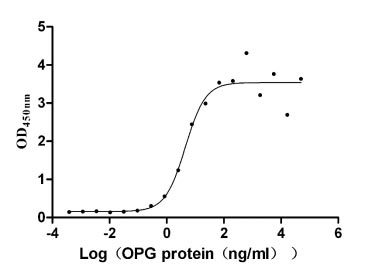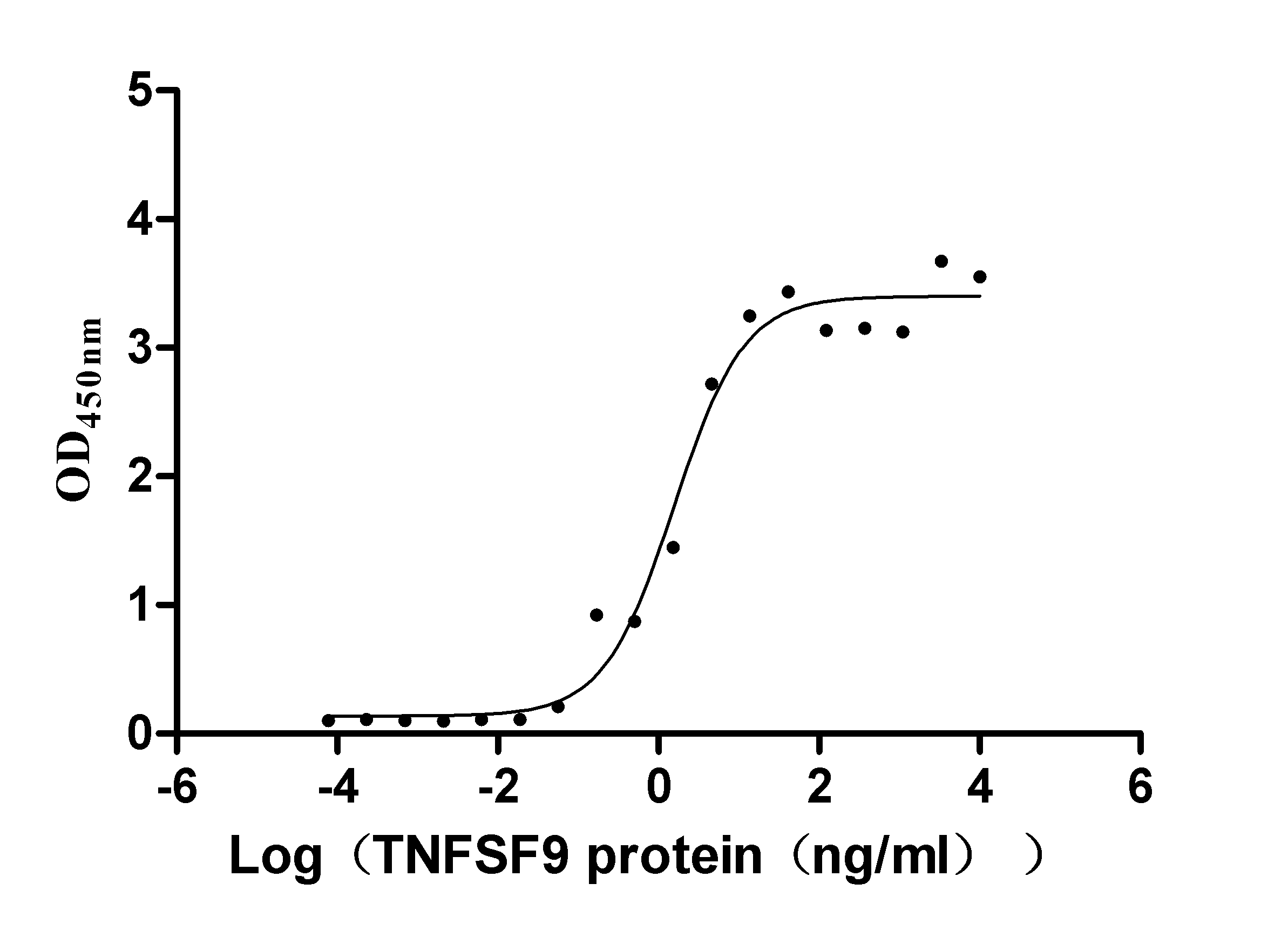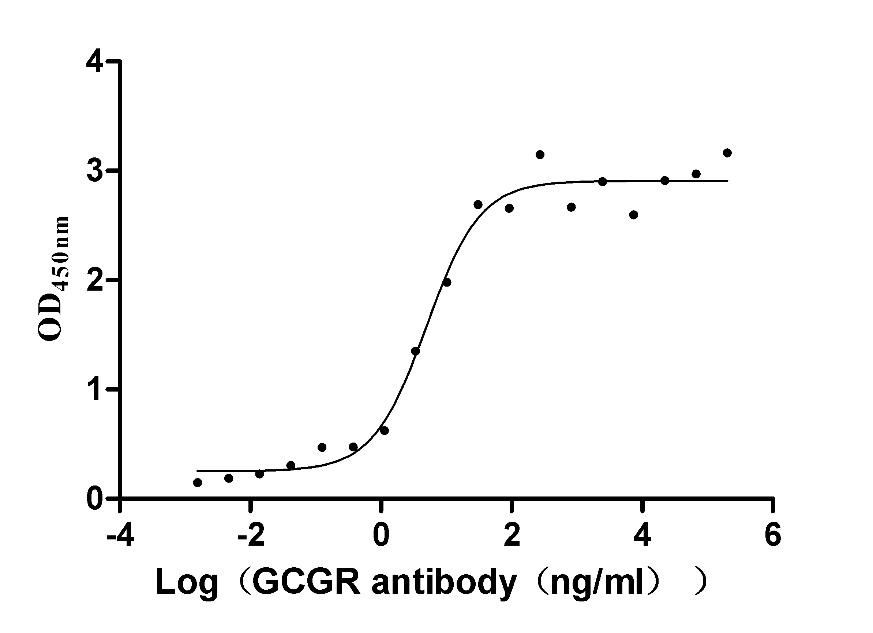Recombinant Human Somatostatin receptor type 5 (SSTR5), partial
-
货号:CSB-YP022728HU1
-
规格:
-
来源:Yeast
-
其他:
-
货号:CSB-EP022728HU1-B
-
规格:
-
来源:E.coli
-
共轭:Avi-tag Biotinylated
E. coli biotin ligase (BirA) is highly specific in covalently attaching biotin to the 15 amino acid AviTag peptide. This recombinant protein was biotinylated in vivo by AviTag-BirA technology, which method is BriA catalyzes amide linkage between the biotin and the specific lysine of the AviTag.
-
其他:
-
货号:CSB-BP022728HU1
-
规格:
-
来源:Baculovirus
-
其他:
-
货号:CSB-MP022728HU1
-
规格:
-
来源:Mammalian cell
-
其他:
产品详情
-
纯度:>85% (SDS-PAGE)
-
基因名:
-
Uniprot No.:
-
别名:SSTR5; Somatostatin receptor type 5; SS-5-R; SS5-R; SS5R
-
种属:Homo sapiens (Human)
-
蛋白长度:Partial
-
蛋白标签:Tag type will be determined during the manufacturing process.
The tag type will be determined during production process. If you have specified tag type, please tell us and we will develop the specified tag preferentially. -
产品提供形式:Lyophilized powder
Note: We will preferentially ship the format that we have in stock, however, if you have any special requirement for the format, please remark your requirement when placing the order, we will prepare according to your demand. -
复溶:We recommend that this vial be briefly centrifuged prior to opening to bring the contents to the bottom. Please reconstitute protein in deionized sterile water to a concentration of 0.1-1.0 mg/mL.We recommend to add 5-50% of glycerol (final concentration) and aliquot for long-term storage at -20℃/-80℃. Our default final concentration of glycerol is 50%. Customers could use it as reference.
-
储存条件:Store at -20°C/-80°C upon receipt, aliquoting is necessary for mutiple use. Avoid repeated freeze-thaw cycles.
-
保质期:The shelf life is related to many factors, storage state, buffer ingredients, storage temperature and the stability of the protein itself.
Generally, the shelf life of liquid form is 6 months at -20°C/-80°C. The shelf life of lyophilized form is 12 months at -20°C/-80°C. -
货期:Delivery time may differ from different purchasing way or location, please kindly consult your local distributors for specific delivery time.Note: All of our proteins are default shipped with normal blue ice packs, if you request to ship with dry ice, please communicate with us in advance and extra fees will be charged.
-
注意事项:Repeated freezing and thawing is not recommended. Store working aliquots at 4°C for up to one week.
-
Datasheet :Please contact us to get it.
相关产品
靶点详情
-
功能:Receptor for somatostatin 28 and to a lesser extent for somatostatin-14. The activity of this receptor is mediated by G proteins which inhibit adenylyl cyclase. Increases cell growth inhibition activity of SSTR2 following heterodimerization.
-
基因功能参考文献:
- Somatostatin receptor 5 variant (sst5TMD4) was expressed in a subset of breast cancers, where it correlated with angiogenic markers, lymphatic metastasis, and reduced disease-free survival. PMID: 27507050
- sst5TMD4 is overexpressed in PCa, especially in those patients with a worse prognosis, and plays an important pathophysiologic role in PCa, which suggesting its potential as a biomarker and/or therapeutic target PMID: 28705809
- In cotransfected HEK-293 cells, SSTR5 and CB1R existed in a constitutive heteromeric complex under basal condition, which was disrupted upon agonist treatments. Furthermore, concurrent receptor activation led to preferential formation of SSTR5 homodimer and dissociation of CB1R homodimer. PMID: 27984180
- A truncated splice variant of the somatostatin receptor subtype 5, is associated to features of increased aggressiveness in pancreatic neuroendocrine tumors. PMID: 26673010
- SSTR5 was the predominantly expressed receptor subtype in the cytoplasm of all GH-secreting adenomas tested, regardless of whether they came from octreotide-naive, octreotide-responsive, or octreotide-resistant patients. SSTR5 mRNA predominance was significant only in octreotide treated patients. Its expression was not correlated with baseline or post-octreotide GH or IGF-1 levels or tumor volume. PMID: 25008035
- This is the first evidence indicating that sst5TMD4 is expressed in human medullary thyroid carcinoma cells, where it associates with more aggressive behavior, suggesting that sst5TMD4 might play a functionally relevant role. PMID: 25854304
- A truncated sst5-variant (sst5TMD4) can influence the secretory response of somatotropinomas to somatostatin analogues-therapy. PMID: 25637790
- SSTR5 protein is overexpressed in poorly differentiated thyroid cancer and may be involved in the lack of response to somatostatin analogue treatment. PMID: 24465589
- High SSTR5 expression is associated with gallbladder cancer. PMID: 23991955
- agonist-selective phosphorylation of carboxyl-terminal Threonine 333 of Sst5, is reported. PMID: 23418396
- Report down-regulation of SSTR-5 expression in operable hepatocellular carcinomas. PMID: 22640914
- Except for SSTR5, all SSTRs showed a tendency toward decreased expression in well-to poorly differentiated neuroendocrine carcinoma of the lung. PMID: 22770972
- Determination of the expression of SSTR5 in an attempt to establish correlations and/or associations with clinical characteristics of patients with nonfunctioning pituitary adenomas. PMID: 22419713
- The rabbit monoclonal antibodies UMB-4 and UMB-1 will facilitate the assessment of the somatostatin receptor status of human tumors during routine histopathological examinations. PMID: 21952553
- SSTR5 P335L is a hypofunctional protein with a potentially harmful effect on function, as well as potential latent effect, and therefore it could affect the clinical response to somatostatin analog therapy for patients with pancreatic cancer. PMID: 21249361
- Our results demonstrate a previously undetected strong association of two SSTR5 single nucleotide polymorphisms with acromegaly PMID: 21810856
- ZDHHC5 and SSTR5 are colocalized at the plasma membrane and coexpression of ZDHHC5 increased palmitoylation of SSTR5 whereas knock-down of endogenous ZDHHC5 by siRNAs decreased it. PMID: 21820437
- differential gene expression profiles revealed more abundant mRNA expression in ectopic ACTH syndrome than in Cushing disease of SSTR-5 PMID: 21383526
- data suggest that SSTR5 genetic variants play a role in pancreatic cancer development and progression PMID: 21692047
- demonstrate that cells transfected with SSTR1 or SSTR1/5 negatively regulates EGF mediated effects attributed to the inhibition of EGFR phosphorylation. PMID: 21419811
- The heterodimerization of somatostatin receptor-5 not only indicate the receptor's specificity of interaction but also provide new insight to understand the molecular mechanism in regulation of signaling pathway in receptor specific manner. PMID: 21238583
- These data indicate that the activation and/or overexpression of SST receptors along with the inhibition of EGFR will serve as an important therapeutic approach in the treatment of ErbB-positive tumors. PMID: 21190959
- Common genetic variation in the IGF1 and SSTR5 genes seems to influence circulating IGF-I levels PMID: 20810604
- This study demonstrated negative immunoreactivity for SSTR-5 in the adenomatous tissue. PMID: 19894022
- importance of Asn13 and/or Asn26 residues in the agonist-specific signalling of hSSTR5 PMID: 20207824
- Potential role of SSTR5 in the response of some tumors to somatostatin receptors. PMID: 20233783
- SSTR5 and CCR7 have a role in Crohn's disease pathogenesis PMID: 20150960
- identified an upstream promoter of the somatostatin receptor 5 gene with tissue-specific activity PMID: 12072395
- the SSTR5 gene is involved in the etiology of bipolar affective disorder or may exist in linkage disequilibrium with a susceptibility gene close to SSTR5. PMID: 12192619
- Results do not suggest the SSTR5 gene as a susceptibility gene for autism PMID: 12898583
- activation of hSSTR5 but not hSSTR1 is necessary for heterodimeric assembly PMID: 15247250
- role for SSTR5 t-461c and c1004t alleles in influencing GH and IGF-I levels in patients with acromegaly, whereas SSTR2 and SSTR5 variants seem to have a minor role in determining the responsiveness to somatostatin analogs PMID: 15914528
- intracellular sorting of the somatostatin receptor subtype 5 is regulated by interactions with PDZ domain proteins PIST/GOPC and PDZK1 PMID: 16012170
- Results suggest that the expression pattern of dopamine receptor 2 and somatostatin receptor 5 may influence the effects of SRIF analogs in growth hormone-secreting pituitary adenomas. PMID: 16216913
- The expression of SSTR5 in TSHoma may be a useful marker for predicting the outcome of octreotide therapy. PMID: 17159301
- The majority of all benign, premalignant and malignant laryngeal specimens expressed moderate to high levels of expression of SSTR5. PMID: 18066572
- Immunohistochemistry stufy of SSTR5 in prostate tissue from patients with bladder outlet obstruction showed that close to 90% of secretory cells showed a weak positivity in the cytoplasm. PMID: 18936524
- SSTR5 mRNA levels in Cushing disease were greater than silent corticotroph adenoma (SCA) but did not differ between non-functioning pituitary tumor and SCA. PMID: 19318729
- investigation of the role of BBXXB and DRY motifs of SST5 in the transduction of intracellular signals involved in the regulation of GH secretion and cell proliferation PMID: 19342453
- The existence of two previously unidentified sst5 spliced variants with distinct distribution in normal tissues and pituitary tumors. PMID: 19401364
- Genetic variation in the SSTR5 gene and, particularly, the rs4988483 single nucleotide polymorphism influence circulating IGFI and IGFBP3 hormone levels with no measurable effect on prostate cancer risk. PMID: 19423539
收起更多
-
亚细胞定位:Cell membrane; Multi-pass membrane protein.
-
蛋白家族:G-protein coupled receptor 1 family
-
组织特异性:Adult pituitary gland, heart, small intestine, adrenal gland, cerebellum and fetal hypothalamus. No expression in fetal or adult kidney, liver, pancreas, uterus, spleen, lung, thyroid or ovary.
-
数据库链接:
HGNC: 11334
OMIM: 182455
KEGG: hsa:6755
STRING: 9606.ENSP00000293897
UniGene: Hs.449840




















